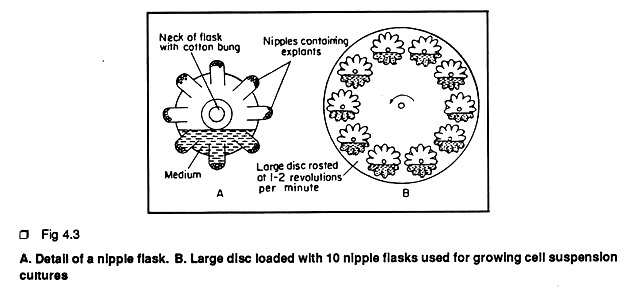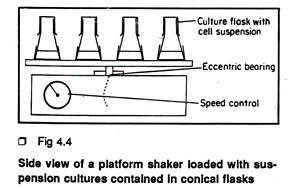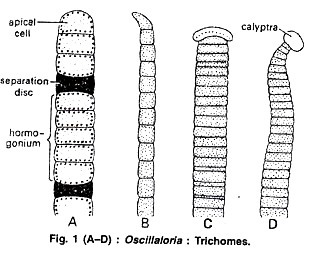ADVERTISEMENTS:
The following points highlight the two types of cell suspension culture. They are: (1) Batch Culture and (2) Continuous Culture System.
Type # 1. Batch Culture:
Batch culture is a type of suspension culture where the cell material grows in a finite volume of agitated liquid medium.
For instance, cell material in 20 ml or 40 ml or 60 ml liquid medium in each passage constitute a batch culture. Batch suspension cultures are most commonly maintained in conical flasks incubated on orbital platform shakers at the speed of 80-120 rpm.
Slowly Rotating Cultures:
ADVERTISEMENTS:
Single cells and cell aggregates are grown in a specially designed flask, the nipple flask. Each nipple flask possesses eight nipple-like projections. The capacity of each flask is 250 ml. Ten flasks are loaded in a circular manner on the large flat disc of a vertical shaker (Fig 4.3). When the flat disc rotates at the speed of 1-2 rpm, the cell within each nipple of the flask are alternately bathed in culture medium and exposed to air.
Shake Cultures:
It is a very simple and effective system of suspension culture. In this method, single cells and cell aggregates in fixed volume of liquid medium are placed in conical flasks. Conical flasks are mounted with the help of clips on a horizontal large square plate of an orbital platform shaker. The square plate moves by a circular motion at the speed of 60-180 rpm (Fig4.4).
Spinning Cultures:
Large volumes of cell suspension may be cultured in 10L bottles which are rotated in a culture spinner at 120 rpm at an angle of 45° (Fig4.5).
Stirred Culture:
This system is also used for large-scale batch culture (1.5 to 10 litres). In this method, the large culture vessel is not rotated but the cell suspension inside the vessel is kept dispersed continuously by bubbling sterile air through culture medium. The use of an internal magnetic stirrer is the most convenient way to agitate the culture medium safely. The magnetic stirrer revolves at 200-600 rpm. The culture vessel is a 5 to 10 litres round-bottom flask (Fig 4.6).
Type # 2. Continuous Culture System:
This system is very much similar to stirred culture. But in this system, the old liquid medium is continuously replaced by the fresh liquid medium to stabilize the physiological states of the growing cells. Normally, the liquid medium is not changed until the depletion of some nutrients in the medium and the cells are kept in the same medium for a certain period.
As a result active growth phase of the cell declines the depletion of nutrient. In continuous culture system, nutrient depletion does not occur due to continuous flow of nutrient medium and the cells always remain in the steady state of active growth phase.
Chemostats:
In this system, culture vessels are generally cylindrical or circular in shape and possess inlet and outlet pores for aeration and the introduction of and removal of cells and medium. The liquid medium containing the cells is stirred by a magnetic stirrer. The introduction of fresh sterile medium, which is pumped in at a constant rate into the vessel is balanced by the displacement of an equal volume of spent or old medium and cells.
Such a system can be maintained in a steady state so that new cells are produced by division at a rate which compensates the number lost in the outflow of spent medium. Thus in a steady state condition the density, growth rate, chemical composition and metabolic activity of the cells all remain constant. Such continuous cultures are ideal for studying growth kinetics and the regulation of metabolic activity in higher plants (Fig4.7).
Turbidostats:
ADVERTISEMENTS:
The turbidity of a suspension culture medium changes rapidly when the cells increase in number due to their steady state growth. The changes of turbidity of the culture medium can be measured by the changes of optical density of the medium.
Again, the pH of the medium changes due to increase of cell density. In turbidostates, an automatic monitoring unit is connected with the culture vessel and such unit adjusts the medium flow in such a way as to maintain the optical density or pH at a chosen, preset level.





